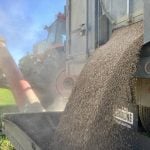Crop input costs are expected to rise in 2026, while crop prices are expected to come down, according to Farm Credit Canada’s analysis.
Canadian farmers are forecasted to spend $22.5 billion on crop inputs in 2026, wrote FCC senior economist Leigh Anderson in a Sept. 10 report.
“This could make 2026 one of the most expensive crop years, potentially rivaling the record set in 2022,” Anderson said.
Fertilizer prices elevated
Fertilizer costs are expected to reach nearly $10 billion.
Read Also

CFIA adds controls for imports of Spanish feed ingredients after African swine fever outbreak
The Canadian Food Inspection Agency (CFIA) has added Spain to a list of countries subject to feed import controls due to an outbreak of African swine fever in that country.
“Fertilizer prices have been rising over the summer, even though this is usually a quiet time when prices tend to drop,” Anderson wrote.
High prices have suppressed summer demand among Canadian farmers — many of whom have delayed purchases.
However, U.S. farmers planted 7.4 per cent more corn than last year, which elevated demand for nitrogen and supported prices. Demand has also been strong in other parts of the world, including Europe.
Global phosphate supplies are tight and prices remain high.
Geopolitics like the war in Ukraine also continue to influence fertilizer supply. A peace deal could ease energy and fertilizer prices and help restart European nitrogen plants. Continued conflict would keep prices high.
Additionally, U.S. tariffs on Russia may increase nitrogen costs, particularly for Eastern Canada.
China has resumed limited exports of urea and phosphate after years of restriction, Anderson added. This could help ease global shortages.
Pressures on crop prices
Canadian farmers are facing the disruption of canola and pea exports to China. Crop price ratios currently favour Canadian farmers planting oilseeds over cereals due to strong biofuel demand. However, Anderson said future demand and acreage will depend on trade disputes with China.
China hasn’t bought any new crop soybeans from the U.S.
“If this continues, both soybean and canola prices could drop further,” Anderson wrote.
FCC’s analysis of fertilizer-to-crop price ratios shows a slight affordability decline for 2026 with potential for that decline to worsen, depending on the trajectory of fertilizer and crop prices.
In the midst of increased uncertainty, Anderson urged farmers to focus on what they can control.
“Leveraging agronomic expertise, economic decision tools, and collaborative relationships with suppliers can help producers realize efficiencies and sustain profitability,” he said.
















